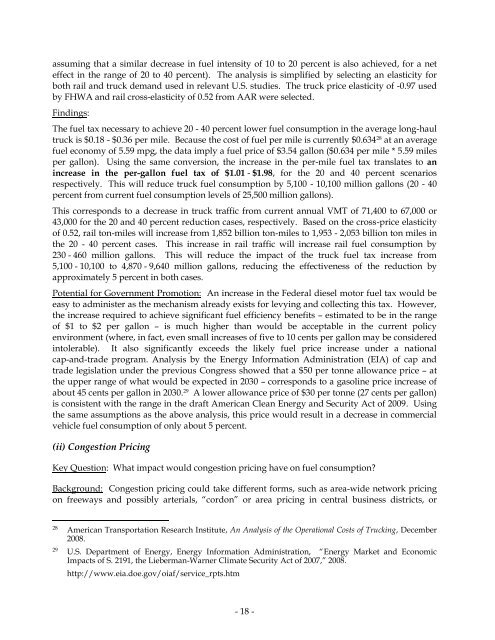Assessment of Fuel Economy Technologies for Medium and Heavy ...
Assessment of Fuel Economy Technologies for Medium and Heavy ...
Assessment of Fuel Economy Technologies for Medium and Heavy ...
Create successful ePaper yourself
Turn your PDF publications into a flip-book with our unique Google optimized e-Paper software.
assuming that a similar decrease in fuel intensity <strong>of</strong> 10 to 20 percent is also achieved, <strong>for</strong> a net<br />
effect in the range <strong>of</strong> 20 to 40 percent). The analysis is simplified by selecting an elasticity <strong>for</strong><br />
both rail <strong>and</strong> truck dem<strong>and</strong> used in relevant U.S. studies. The truck price elasticity <strong>of</strong> -0.97 used<br />
by FHWA <strong>and</strong> rail cross-elasticity <strong>of</strong> 0.52 from AAR were selected.<br />
Findings:<br />
The fuel tax necessary to achieve 20 - 40 percent lower fuel consumption in the average long-haul<br />
truck is $0.18 - $0.36 per mile. Because the cost <strong>of</strong> fuel per mile is currently $0.634 28 at an average<br />
fuel economy <strong>of</strong> 5.59 mpg, the data imply a fuel price <strong>of</strong> $3.54 gallon ($0.634 per mile * 5.59 miles<br />
per gallon). Using the same conversion, the increase in the per-mile fuel tax translates to an<br />
increase in the per-gallon fuel tax <strong>of</strong> $1.01 - $1.98, <strong>for</strong> the 20 <strong>and</strong> 40 percent scenarios<br />
respectively. This will reduce truck fuel consumption by 5,100 - 10,100 million gallons (20 - 40<br />
percent from current fuel consumption levels <strong>of</strong> 25,500 million gallons).<br />
This corresponds to a decrease in truck traffic from current annual VMT <strong>of</strong> 71,400 to 67,000 or<br />
43,000 <strong>for</strong> the 20 <strong>and</strong> 40 percent reduction cases, respectively. Based on the cross-price elasticity<br />
<strong>of</strong> 0.52, rail ton-miles will increase from 1,852 billion ton-miles to 1,953 - 2,053 billion ton miles in<br />
the 20 - 40 percent cases. This increase in rail traffic will increase rail fuel consumption by<br />
230 - 460 million gallons. This will reduce the impact <strong>of</strong> the truck fuel tax increase from<br />
5,100 - 10,100 to 4,870 - 9,640 million gallons, reducing the effectiveness <strong>of</strong> the reduction by<br />
approximately 5 percent in both cases.<br />
Potential <strong>for</strong> Government Promotion: An increase in the Federal diesel motor fuel tax would be<br />
easy to administer as the mechanism already exists <strong>for</strong> levying <strong>and</strong> collecting this tax. However,<br />
the increase required to achieve significant fuel efficiency benefits – estimated to be in the range<br />
<strong>of</strong> $1 to $2 per gallon – is much higher than would be acceptable in the current policy<br />
environment (where, in fact, even small increases <strong>of</strong> five to 10 cents per gallon may be considered<br />
intolerable). It also significantly exceeds the likely fuel price increase under a national<br />
cap-<strong>and</strong>-trade program. Analysis by the Energy In<strong>for</strong>mation Administration (EIA) <strong>of</strong> cap <strong>and</strong><br />
trade legislation under the previous Congress showed that a $50 per tonne allowance price – at<br />
the upper range <strong>of</strong> what would be expected in 2030 – corresponds to a gasoline price increase <strong>of</strong><br />
about 45 cents per gallon in 2030. 29 A lower allowance price <strong>of</strong> $30 per tonne (27 cents per gallon)<br />
is consistent with the range in the draft American Clean Energy <strong>and</strong> Security Act <strong>of</strong> 2009. Using<br />
the same assumptions as the above analysis, this price would result in a decrease in commercial<br />
vehicle fuel consumption <strong>of</strong> only about 5 percent.<br />
(ii) Congestion Pricing<br />
Key Question: What impact would congestion pricing have on fuel consumption<br />
Background: Congestion pricing could take different <strong>for</strong>ms, such as area-wide network pricing<br />
on freeways <strong>and</strong> possibly arterials, ―cordon‖ or area pricing in central business districts, or<br />
28<br />
American Transportation Research Institute, An Analysis <strong>of</strong> the Operational Costs <strong>of</strong> Trucking, December<br />
2008.<br />
29<br />
U.S. Department <strong>of</strong> Energy, Energy In<strong>for</strong>mation Administration, ―Energy Market <strong>and</strong> Economic<br />
Impacts <strong>of</strong> S. 2191, the Lieberman-Warner Climate Security Act <strong>of</strong> 2007,‖ 2008.<br />
http://www.eia.doe.gov/oiaf/service_rpts.htm<br />
- 18 -
















